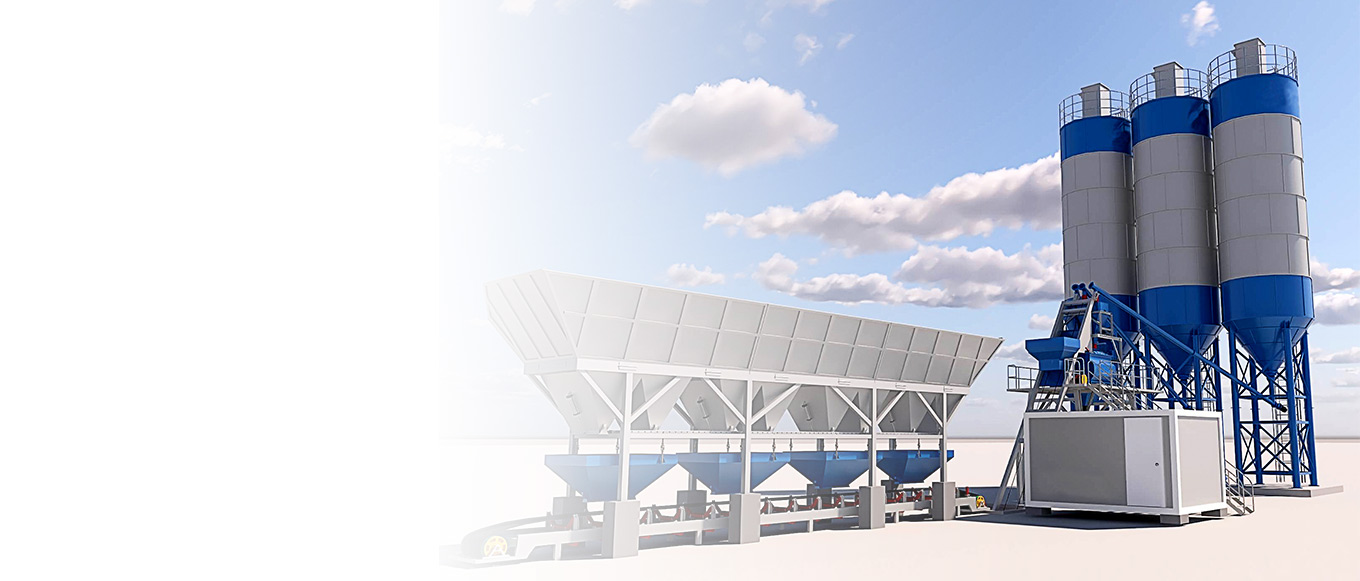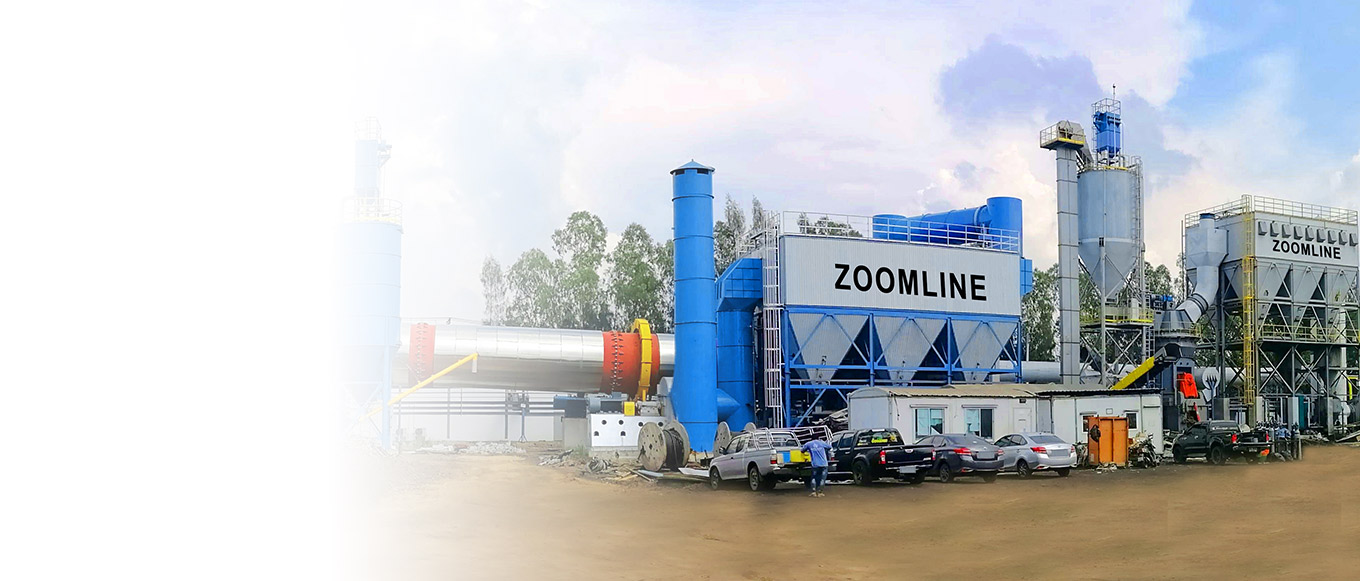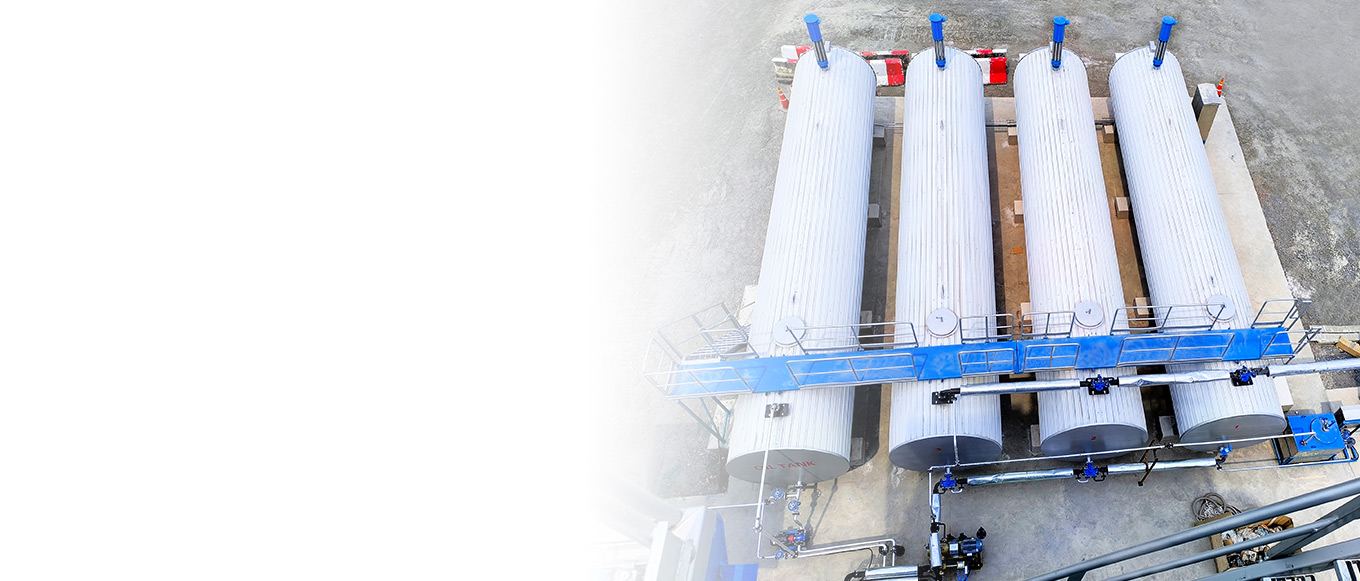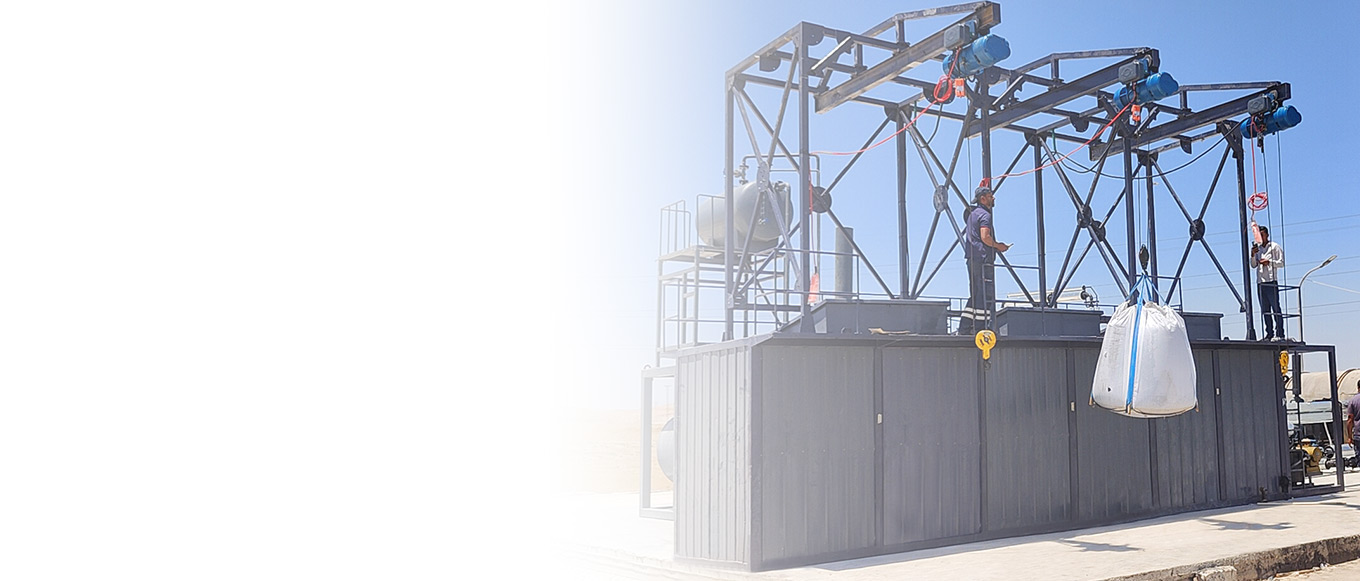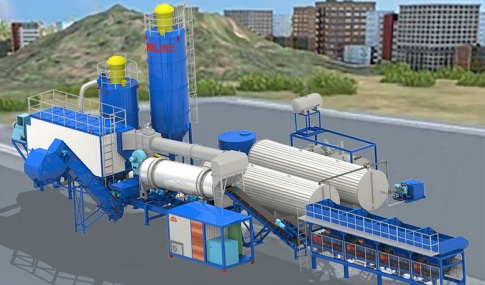Introduction to Bitumen Tank
An bitumen tank is a specially designed industrial device used for storing, heating, and transporting liquid asphalt (and asphalt mixtures). It features high strength and durability, enabling it to operate normally in high-temperature and corrosive environments. Its primary purpose is to ensure that asphalt remains in a usable liquid state, facilitating seamless supply throughout production, construction, and distribution processes. bitumen tanks play a crucial role in asphalt mixing plants, refineries, construction projects, and waterproofing engineering.
Application Scene Of Bitumen Tank
Asphalt Mixing Plant
In the efficient operation system of an asphalt mixing plant, the bitumen tank serves as the core hub, playing a crucial role. It not only enables the classification storage of asphalt of different grades and temperatures to prevent performance degradation caused by mixing but is also equipped with advanced heating and insulation systems to ensure the asphalt inside the tank remains in a liquid state, facilitating precise metering and delivery to the mixing equipment. Through an automated control system, the bitumen tank can coordinate with other equipment in the mixing plant to achieve precise ratios of asphalt delivery with aggregates and additives, thereby consistently producing high-quality asphalt mixtures that meet engineering standards, laying a solid foundation for road construction.

Bitumen Refining and Distribution
In the refining and distribution segment of the asphalt industry chain, bitumen tanks serve as a stable logistics node. Large vertical bitumen tanks, with their 10,000 tons storage capacity, serve as “temporary warehouses” for finished asphalt from refineries. During storage, temperature control and nitrogen protection technology effectively slow down asphalt oxidation and degradation. Additionally, the bitumen tank area is equipped with oil pumps, pipeline networks, and metering systems to enable precise packaging and rapid transportation of asphalt. Whether transported via rail tank cars, road tankers, or connected to maritime terminals, bitumen tanks ensure seamless integration between different transportation modes, maintaining the stable and efficient operation of the supply chain and ensuring timely delivery of asphalt to end-users nationwide.
Building and Waterproofing
In road construction, the application of bitumen tanks significantly enhances construction flexibility. Mobile bitumen tank trucks can directly enter construction sites, using their built-in heating devices and pumping systems to deliver asphalt to paving machines, reducing losses and temperature drop caused by long-distance pipeline transportation. This is particularly suitable for construction in complex environments such as mountainous roads and rural highways. In waterproofing projects, bitumen tanks are indispensable key equipment. Especially in roof waterproofing construction for large commercial buildings and industrial facilities, thermoplastic modified asphalt must be applied at high temperatures. Specialized vehicle-mounted bitumen tanks can continuously heat and mix asphalt in real-time, and through high-pressure spraying equipment, achieve continuous operation. This not only improves construction efficiency but also ensures the uniformity and sealing of the waterproof layer, effectively resisting water penetration and extreme weather erosion, providing buildings with durable and reliable waterproof protection.
Key Components of a Bitumen Tank
- Inner shell and cover: The inner shell is fabricated from high-strength steel plates via welding, seamlessly integrated with convex or flat heads to form the tank body. The tank lid is equipped with precision fastening devices, and high-elasticity sealing strips are embedded between the lid and tank opening, creating dual leak-proof protection to ensure asphalt safety during storage and transportation.
- High-efficiency insulation layer: A support framework is constructed using angle steel and wooden strips, with high-performance insulation materials such as glass wool, rock wool, or perlite filled inside, forming a rigorous thermal insulation system that effectively reduces heat loss and maintains a constant asphalt temperature.
- Protective outer shell: The steel plate outer shell located outside the insulation layer acts as a sturdy armor, providing mechanical protection and environmental resistance for the bitumen tank, thereby extending the equipment’s service life.
- Intelligent heating system: Integrated with heaters and a gas heating system, it uses precise temperature control technology to maintain continuous heating, ensuring the asphalt remains in an ideal flow state to meet various operational requirements.
- Inlet and outlet asphalt lines: A scientifically designed inlet and outlet piping system, combined with optimized pipe diameters and layout, enables rapid and stable asphalt input and output, ensuring construction efficiency.
- Bitumenpump: A high-performance asphalt pump serves as the core conveyance component, featuring strong suction and stable flow output capabilities, enabling rapid extraction of asphalt from the tank and adaptability to various construction scenarios.
- Temperature measuring instrument: Built-in high-precision temperature measurement instruments enable real-time dynamic monitoring and data feedback of asphalt temperature, ensuring it remains within the required process range.
- Sturdy support structure: Customized fixed brackets made of high-strength materials and mechanically optimized design provide reliable support for the bitumen tank, ensuring stable operation of the equipment.
Additionally, depending on different scenarios and requirements, the bitumen tank may include components such as a steam generator, piping and asphalt pump preheating system, pressure relief system, steam fuel supply system, tank cleaning system, and oil unloading into the tank device.
How Do Bitumen Tanks Work
As the core equipment for asphalt storage, the bitumen tank’s primary function is to maintain the asphalt in a liquid working state. By integrating an efficient heating system and utilizing diverse heating methods such as direct combustion burners, thermal oil circulation, or electric heating, the tank precisely controls the tank temperature to effectively prevent asphalt from cooling and solidifying.
In terms of tank construction, high-performance insulation materials such as rock wool and polyurethane foam are used to form a dense insulation layer, significantly reducing heat loss and maintaining stable temperature control even during peak operational periods. Additionally, an intelligent temperature monitoring and control system provides real-time data feedback, automatically adjusting heating power to eliminate the risk of temperature instability.
Modern bitumen tanks are also equipped with comprehensive automation components. In addition to basic pumping and discharge systems, they integrate safety modules such as pressure safety valves and liquid level overflow prevention devices, enabling intelligent management throughout the entire process from storage to transportation, ensuring safe and efficient operation of the equipment.
Types of Bitumen Tanks
To facilitate precise selection, bitumen tanks can be classified based on core standards:
Classification by Mobility
- Fixed-type: Permanently installed at construction sites, these tanks offer excellent long-term storage performance and are particularly suitable for scenarios with stringent requirements for asphalt storage stability, such as asphalt mixing plants and large-scale road maintenance bases.
- Mobile: Featuring modular design and towable structures, these tanks offer flexible transportation capabilities, specifically designed for temporary projects, emergency road repairs, and other applications requiring frequent changes in work locations, meeting short-term efficient storage and supply needs.
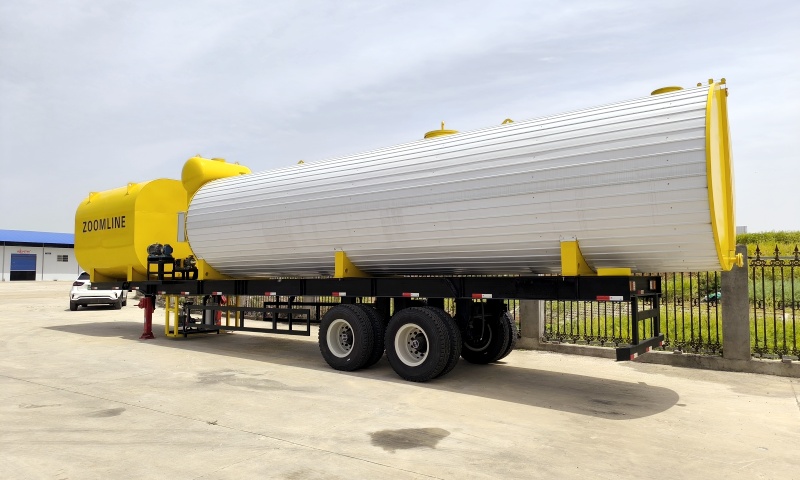
Classification by Structural Form
- Horizontal bitumen tanks: Installed in a horizontal orientation, these tanks offer ultra-large storage capacity, particularly suitable for large-scale projects with massive asphalt reserve requirements, ensuring continuous supply during construction.
- Vertical bitumen tanks: Characterized by vertical installation, their primary advantage is space-saving, making them ideal for construction sites with limited space, enabling efficient storage in confined areas.
- Container-type bitumen tanks: Based on standard container modular design, they combine convenient transportation with flexible stacking capabilities, making them highly suitable for projects requiring frequent relocation and high mobility.
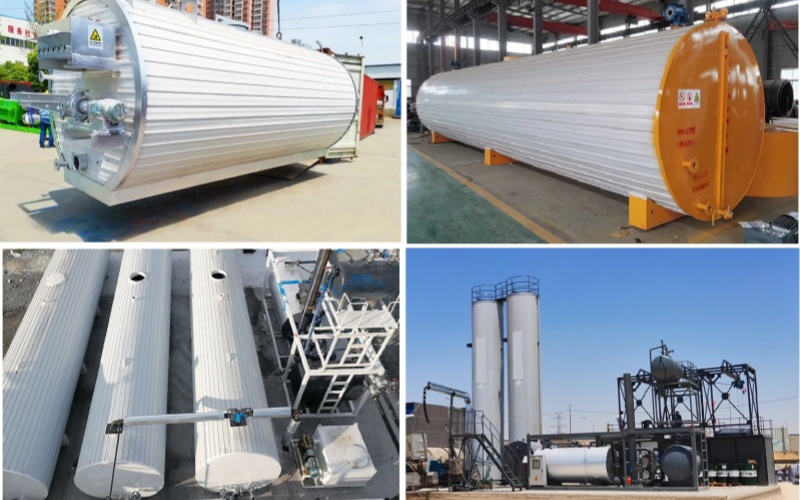
Classification by Heating Method
- Direct heating type: Utilizes direct heating technology to rapidly increase asphalt temperature, offering high heating efficiency but requiring extremely precise temperature control. Suitable for emergency construction scenarios with strict heating speed requirements.
- Thermal oil heating type: Uses thermal oil for indirect heat transfer, enabling precise temperature regulation and effectively preventing asphalt performance degradation caused by localized overheating. Suitable for professional applications with stringent asphalt quality requirements.
Classification by Usage
- Specialized Storage Type: Designed for long-term stable storage of asphalt, equipped with comprehensive insulation and anti-oxidation systems to ensure asphalt maintains optimal physical and chemical properties throughout the storage period.
- Specialized Transportation Type: Features reinforced structures and leak-proof designs, integrated with professional temperature control systems and safety protection devices to ensure the safety and stability of asphalt during long-distance transportation.
Classification by Capacity
Capacity classification is the most intuitive method of distinction, with common measurement units including liters, gallons, and cubic meters. Although there is no unified standard, it is typically categorized as follows:
- Small (≤25,000 liters): Suitable for road maintenance, small-scale repairs, and other projects with limited scope;
- Medium-sized (25,000–80,000 liters): Suitable for medium-scale municipal projects and regional road construction;
- Large-sized (>80,000 liters): Primarily serves large-scale infrastructure projects such as highways and airport runways.
Heating Methods for Bitumen Tanks
Based on electromagnetic induction or resistance heating principles, electric heating technology can heat asphalt from room temperature to over 160°C within 1–2 hours, with temperature regulation accuracy of ±1°C. This method achieves precise temperature control through an intelligent temperature control system, completely unaffected by external factors such as weather or ambient temperature, making it particularly suitable for road construction scenarios with stringent temperature control requirements. However, heating 1 ton of asphalt to construction temperature consumes approximately 80-100 kWh of electricity, resulting in higher long-term costs. It is more suitable for small-scale projects or temporary work sites.
• Direct flame heating:
This method involves direct flame contact with the bitumen tank, enabling rapid temperature increases of 30-50°C per hour in cold environments. It offers significant advantages in northern winter construction. However, professional operators must monitor the flame size and position in real-time to prevent localized overheating that could cause asphalt aging. Due to the risk of fire or explosion from open flames, strict adherence to safety procedures and the provision of fire safety equipment are required. This method is commonly used in remote construction areas with limited power supply.
• Tank circulation heating:
This method uses built-in heating coils in conjunction with an asphalt circulation pump to ensure uniform heating of the asphalt as it flows. Compared to traditional heating methods, it can achieve energy savings of 30%-40%. This technology is particularly suitable for asphalt storage scenarios with long storage periods requiring constant temperature maintenance. However, the heating rate is approximately 1-2°C per hour, making it less efficient for urgent high-temperature asphalt requirements. Additionally, the system requires regular maintenance of the circulation pump and heating equipment, and initial setup necessitates dedicated heating units and circulation piping.
• Thermal oil heating:
Utilizing thermal oil as a heat transfer medium, high-temperature heat transfer above 300°C can be achieved at low pressure (0.3-0.5 MPa). The new bitumen tank equipped with the patented “partial oil extraction” technology can extract 10 tons of 180°C asphalt from a 5,000-ton storage tank within 20 minutes without heating the entire tank, achieving an oil extraction rate of over 98%. However, the system includes complex components such as a thermal oil furnace, circulation pump, and expansion tank, resulting in a longer installation and commissioning period. The initial investment cost is 40%-60% higher than that of direct heating equipment, making it more suitable for large-scale asphalt production bases or long-term fixed operation sites.
Features of Bitumen Tanks
Modern bitumen tanks offer numerous advantages that enhance efficiency and value:
Energy-saving design reduces energy costs
Innovative heating and structural designs achieve energy savings, such as heat pipes (superconducting) direct-heating systems with high thermal efficiency; horizontal tanks use zone heating and floating oil extraction technology for on-demand heating; some equipment can reach optimal operating temperatures at low pressure, and multiple measures reduce energy waste and lower fuel costs.
Diverse capacities to meet project requirements
Bitumen tanks offer a wide range of capacities, with small tanks of a few tons suitable for maintenance projects and large tanks of hundreds of tons capable of meeting the demands of large-scale infrastructure projects. For example, the Meitong Construction Machinery 25-ton transport tank reduces refueling frequency, ensuring continuous production.
Environmental design with strict control of pollution emissions
Modern bitumen tanks utilize clean energy sources such as natural gas or fuel oil to control exhaust emissions; optimized structures minimize impurity contamination, avoiding additional environmental costs due to degraded asphalt performance.
Intelligent control to enhance production efficiency
Equipped with a microcomputer management system for automated storage and measurement; digital temperature control and liquid level display enable precise monitoring; automatic control allows one-button parameter settings, reducing human interference and ensuring stable product quality.
Multi-layer protection for safe operation
Low-pressure high-temperature heating systems and pressure relief devices ensure safe operation; the “ultra-low liquid level oil extraction” function prevents pump dry running; high-quality insulation structures and materials maintain stable asphalt performance.
Compact integration for easy maintenance and deployment
The integrated structural design makes the equipment easy to move, facilitating efficient maintenance and inspections; fixed installation saves space and improves site utilization.
Maintenance Suggestions for Bitumen Tank
To ensure the long-term stable operation of the bitumen tank and extend the equipment’s lifecycle, we provide the following practical maintenance recommendations:
Regular inspection of the heating system
Periodic inspections should be conducted on the bitumen tank’s heating elements, temperature sensors, and heat transfer fluid circulation pumps. Ensure there are no overheating, short circuits, or leaks. If any abnormalities are detected, immediately stop heating and contact professional personnel for handling.
Clean the storage tank and filter
Regularly remove sediment and impurities from the bottom of the storage tank to maintain asphalt quality. Simultaneously inspect and clean the filter to prevent blockages during asphalt transportation. The cleaning frequency should be determined based on actual usage conditions.

Maintain the cleanliness of the control system
As the core of the bitumen tank, regularly remove dust and dirt from the surface and interior of the control cabinet. Simultaneously inspect the wiring inside the cabinet for loose or aged connections to ensure stable operation of the control system.
Ensure the insulation performance of the equipment
The insulation effectiveness of the bitumen tank directly impacts the quality of asphalt storage. Regularly inspect the integrity of the insulation layer and promptly repair or replace damaged or peeling insulation materials.
Perform daily maintenance on emulsifiers and conveyance pumps
Conduct daily maintenance on emulsifiers and conveyance pumps, including checking lubricant oil levels and quality, cleaning internal and external dirt and debris from the equipment, and tightening loose components. Additionally, monitor the equipment’s operational status and observe for any abnormal noises or vibrations.
Regularly inspect the electrical control cabinet
As the central hub of the electrical control system, the electrical control cabinet must be regularly inspected to ensure that electrical components are securely connected, with no signs of burning or damage, and to clean any dust or debris inside. Additionally, ensure the grounding system is safe and reliable.
Avoid low-temperature storage
Asphalt tends to harden and solidify in low-temperature environments. During winter or in low-temperature conditions, maintain an appropriate temperature inside the tank by adding insulation materials or activating the heating system.
Maintenance points for long-term non-use
If the bitumen tank is idle for an extended period, drain the asphalt from the tank or add a corrosion inhibitor to prevent aging; shut off the heating system and power supply; regularly inspect the tank body and auxiliary equipment to ensure normal operation upon subsequent use.
How to Choose the Right Bitumen Tank
- Consider the construction site: If the site area is large, prioritize horizontal bitumen tanks; if space is limited, choose vertical bitumen tanks.
- Clarify the usage scenario: Is it for long-term storage, transportation, or processing modified asphalt? For example, storing modified asphalt and asphalt emulsion requires tanks with mixers, as mixers are crucial for preventing the final product from solidifying or losing performance. Depending on customer requirements, modified asphalt production can also be conducted within the tank, in which case the bitumen tankwill include an asphalt additive chamber.
- Heating requirements: If temperature precision is a priority, choose a thermal oil-heated system; if environmental friendliness and energy efficiency are priorities, choose an electric heating system, while balancing initial costs and long-term efficiency. Heat transfer oil-heated bitumen tanks have higher initial investment costs than electric heating systems but offer advantages in seamless operation and more efficient asphalt system performance.
- Bitumentype: Modified bitumenor bitumen emulsion requires a storage tank with a stirrer to prevent product solidification or loss of performance. The selection should be determined based on the type of asphalt.
Conclusion
In summary, bitumen tanks are indispensable for storing, heating, and supplying asphalt across various industries, from road construction to waterproofing projects. Selecting the appropriate type, heating method, and maintaining the tank properly ensures efficient and safe operation while minimizing costs.


